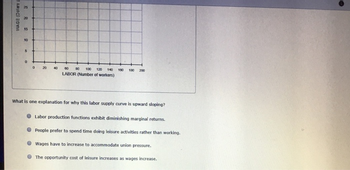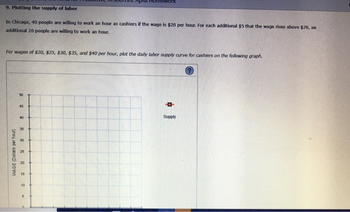
ENGR.ECONOMIC ANALYSIS
14th Edition
ISBN: 9780190931919
Author: NEWNAN
Publisher: Oxford University Press
expand_more
expand_more
format_list_bulleted
Question

Transcribed Image Text:WAGE (Dollars p
10
20
15
10
5
0
0
20
40
60 80 100 120 140
LABOR (Number of workers)
100 100 200
What is one explanation for why this labor supply curve is upward sloping?
Labor production functions exhibit diminishing marginal returns.
People prefer to spend time doing leisure activities rather than working.
Wages have to increase to accommodate union pressure.
The opportunity cost of leisure increases as wages increase.

Transcribed Image Text:9. Plotting the supply of labor
In Chicago, 40 people are willing to work an hour as cashiers if the wage is $20 per hour. For each additional $5 that the wage rises above $20, an
additional 20 people are willing to work an hour.
For wages of $20, $25, $30, $35, and $40 per hour, plot the daily labor supply curve for cashiers on the following graph.
WAGE (Dollars per hour)
50
46
40
35
30
25
20
15
pia Homework
10
5
-0-
Supply
Expert Solution
This question has been solved!
Explore an expertly crafted, step-by-step solution for a thorough understanding of key concepts.
This is a popular solution
Trending nowThis is a popular solution!
Step by stepSolved in 3 steps with 2 images

Knowledge Booster
Learn more about
Need a deep-dive on the concept behind this application? Look no further. Learn more about this topic, economics and related others by exploring similar questions and additional content below.Similar questions
- Look at the diagram below. Let's assume that aggregate demand declines and a recession occurs, which causes a decrease in the demand for labor. Assuming prices, wages and salaries are sticky, then what is the total excess labor? Salary $45,000 $25,000 5000 11000 19000 Labor S D₁ Doarrow_forwardIf an individual labor supply curve bends backward at some high wage, so does the market labor supply curve. True or False?arrow_forwardFill in the blanks: Workers Employed 0 1 2 3 4 Quantity Produced 0 15 25 33 39 Output Price ($) 10 10 10 10 10 Refer to the above table for a profit-maximizing, competitive firm. If the prevailing wage is $100, then the firm will hire worker(s).arrow_forward
- Explain efficiency wage theory Only typed solutionarrow_forwardhelp please answer in text form with proper workings and explanation for each and every part and steps with concept and introduction no AI no copy paste remember answer must be in proper format with all workingarrow_forwardplease also do the graph thank youarrow_forward
arrow_back_ios
arrow_forward_ios
Recommended textbooks for you

 Principles of Economics (12th Edition)EconomicsISBN:9780134078779Author:Karl E. Case, Ray C. Fair, Sharon E. OsterPublisher:PEARSON
Principles of Economics (12th Edition)EconomicsISBN:9780134078779Author:Karl E. Case, Ray C. Fair, Sharon E. OsterPublisher:PEARSON Engineering Economy (17th Edition)EconomicsISBN:9780134870069Author:William G. Sullivan, Elin M. Wicks, C. Patrick KoellingPublisher:PEARSON
Engineering Economy (17th Edition)EconomicsISBN:9780134870069Author:William G. Sullivan, Elin M. Wicks, C. Patrick KoellingPublisher:PEARSON Principles of Economics (MindTap Course List)EconomicsISBN:9781305585126Author:N. Gregory MankiwPublisher:Cengage Learning
Principles of Economics (MindTap Course List)EconomicsISBN:9781305585126Author:N. Gregory MankiwPublisher:Cengage Learning Managerial Economics: A Problem Solving ApproachEconomicsISBN:9781337106665Author:Luke M. Froeb, Brian T. McCann, Michael R. Ward, Mike ShorPublisher:Cengage Learning
Managerial Economics: A Problem Solving ApproachEconomicsISBN:9781337106665Author:Luke M. Froeb, Brian T. McCann, Michael R. Ward, Mike ShorPublisher:Cengage Learning Managerial Economics & Business Strategy (Mcgraw-...EconomicsISBN:9781259290619Author:Michael Baye, Jeff PrincePublisher:McGraw-Hill Education
Managerial Economics & Business Strategy (Mcgraw-...EconomicsISBN:9781259290619Author:Michael Baye, Jeff PrincePublisher:McGraw-Hill Education


Principles of Economics (12th Edition)
Economics
ISBN:9780134078779
Author:Karl E. Case, Ray C. Fair, Sharon E. Oster
Publisher:PEARSON

Engineering Economy (17th Edition)
Economics
ISBN:9780134870069
Author:William G. Sullivan, Elin M. Wicks, C. Patrick Koelling
Publisher:PEARSON

Principles of Economics (MindTap Course List)
Economics
ISBN:9781305585126
Author:N. Gregory Mankiw
Publisher:Cengage Learning

Managerial Economics: A Problem Solving Approach
Economics
ISBN:9781337106665
Author:Luke M. Froeb, Brian T. McCann, Michael R. Ward, Mike Shor
Publisher:Cengage Learning

Managerial Economics & Business Strategy (Mcgraw-...
Economics
ISBN:9781259290619
Author:Michael Baye, Jeff Prince
Publisher:McGraw-Hill Education